As an Amazon Associate, I earn from qualifying purchases with no additional costs for you.
In addition to spikey cacti, vast deserts, and vivid sunsets, Arizona has an abundance of gorgeous rocks and minerals that will put a smile on any rockhound’s face. This list will provide a detailed overview of the different kinds of rocks and minerals you can find in the Grand Canyon State, as well as their rockhounding sites and locations.
In Arizona, the most common rocks and minerals you can find are:
- sandstone,
- limestone,
- granite,
- diorite,
- basalt,
- turquoise,
- agate,
- amethyst,
- garnet,
- and peridot.
Although Arizona is brimming with unique rocks and minerals, it’s a challenging place to go rockhounding unless you have an idea of what you are looking for and where to find it. Before you visit the Grand Canyon State, look over this list of rocks and minerals, along with their locations, so that you can rockhound with confidence.
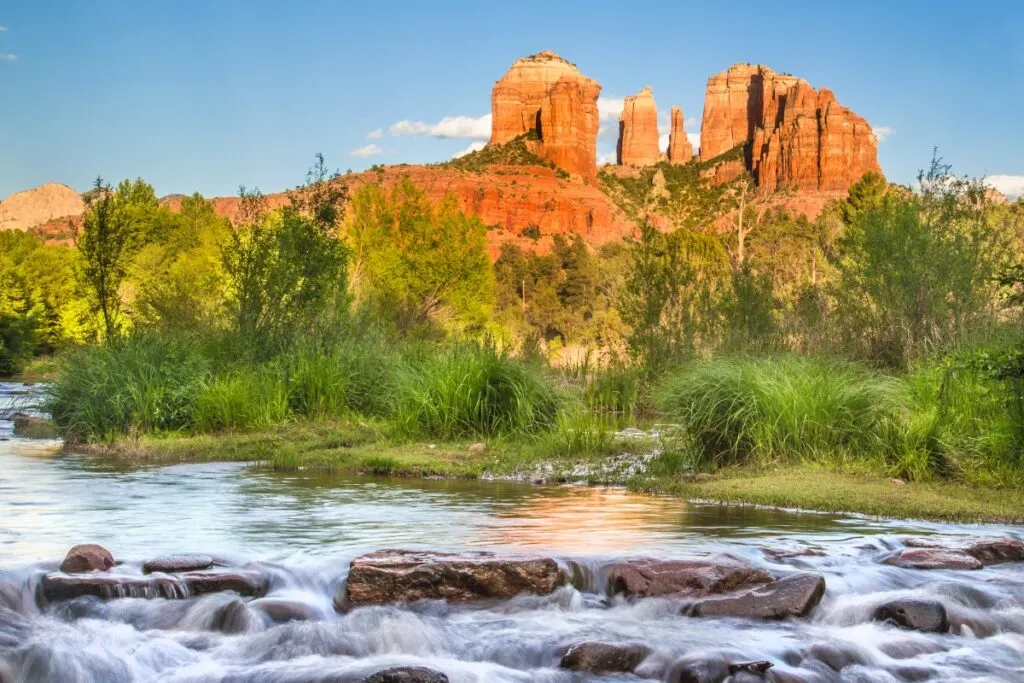
If you are interested in checking out the best rockhounding tools you can find them by clicking here (Amazon link).
What Rocks Are Found in Arizona
It’s no surprise that Arizona, a state known for its mountains and sandy terrain, is home to many different types of rocks, including:
Sandstone
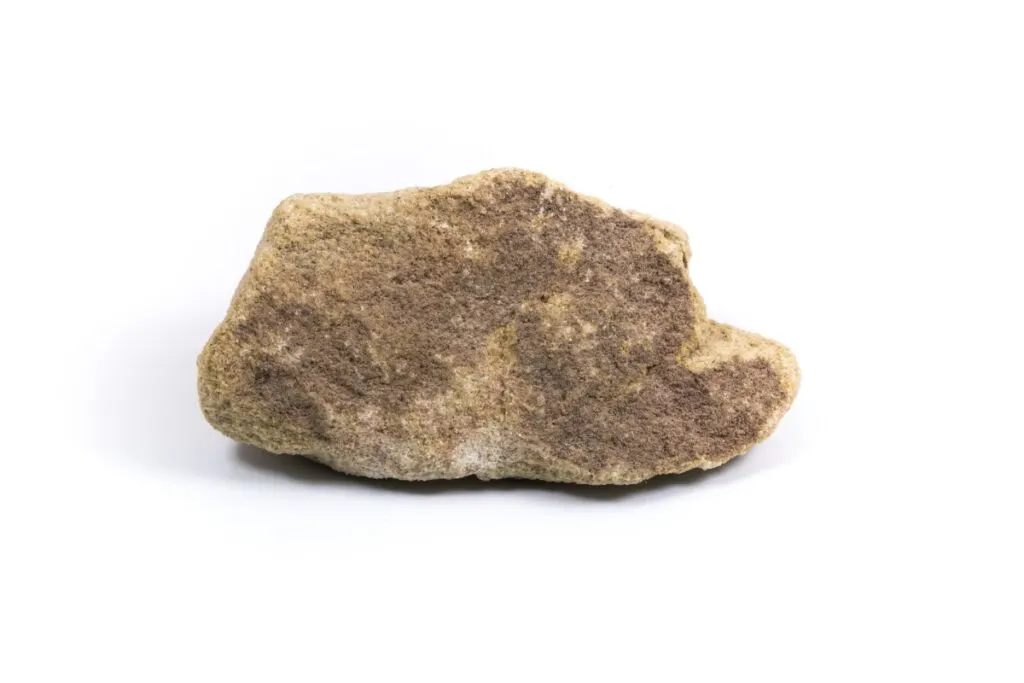
| Location | GPS Coordinates |
|---|---|
| Page | 36.917242, -111.472646 |
| Marble Canyon | 36.825114, -111.655730 |
| Sedona | 34.839720, -111.770935 |
| White Mountains (surrounding areas) | 33.876242, -109.589542 |
| Coconino County | 36.976709, -111.956683 |
| Lake Powell | 36.937796, -111.481453 |
| Jacob Lake | 36.744334, -112.127012 |
Arizona, Nevada, Utah, and Colorado are the only states in the U.S. that possess a special type of sandstone called Navajo Sandstone.
If you enjoy collecting ancient rocks, take home a piece of Navajo Sandstone, which was created by sand that was deposited in the U.S. approximately 190 million years ago.
This particular type of sandstone has colorful streaks of tan and red cross-bedding that look similar to waves, and it naturally forms cliffs, domes, bluffs, and rock formations.
As a matter of fact, one of the most colorful and unique rock formations in Arizona was naturally formed from Navajo Sandstone, and it’s called The Wave.
Another famous sandstone passage that’s particularly breathtaking is Antelope Canyon, which is a narrow, winding pathway that’s composed almost entirely of Navajo Sandstone.
If you’re looking for Navajo Sandstone to place in your collection, add northern Arizona to your route.
Some of the best spots to go for Navajo Sandstone are Page and the surrounding areas along the Utah border. Other areas of Arizona that contain sandstone include Sedona, the White Mountains, and counties near central Arizona.
Limestone
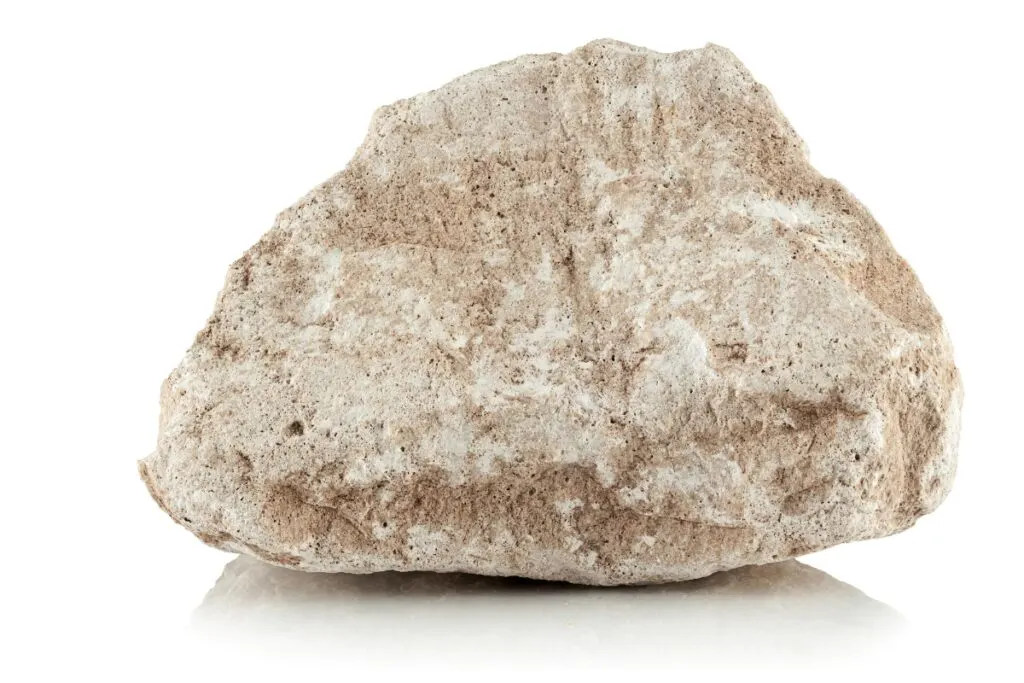
| Location | GPS Coordinates |
|---|---|
| Graham County | 33.000164, -109.572156 |
| Pinal | 33.189047, -111.172466 |
| Coconino County | 35.663711, -111.800630 |
| Page | 36.890069, -111.505775 |
| Tucson | 32.142431, -110.720398 |
| Scottsdale | 33.622327, -111.851645 |
| Jerome | 34.767408, -112.117923 |
| Winona | 35.224152, -111.416171 |
Without a doubt, many U.S. states have plenty of limestone, and Arizona is no exception. However, unlike other states, Arizona has an ancient and highly durable type of limestone called Escabrosa Limestone.
Pieces of Escabrosa Limestone range from pearly white to dark gray in color, and they were created by the sea around 330 million years ago.
One of the world’s 10 most interesting caves, Kartchner Caverns, is composed of Escabrosa Limestone and is located in Benson, Arizona.
Another type of limestone that can be found in Arizona is Kaibab Limestone, and rockhounds sometimes find fossils scattered throughout the light-grey slabs. This limestone has a yellow hue to it and is often found near cliffs or along the rim of the Grand Canyon.
Whether you are searching for Escabrosa or Kaibab Limestone, you are in the right place. For Escabrosa Limestone, check out Graham County, Pinal County, and southeastern Arizona. For Kaibab Limestone, stop by Coconino County, Page, and northern Arizona.
Recommendation box: All tools and equipment you need for rockhounding and rock identification* (Amazon links):
1. Estwing Rock Hammer – Light, comfortable, and extremely durable hammer.
2. Estwing Geologist Pick – Classic and the most trusted paleo pick in the world.
3. Finder 12-inch Chisels – Heavy-duty chisels set with hand protection.
4. Mini Handle Shovel – This is a great tool for digging deep in the dirt.
5 Ironclad Utility Work Gloves – Breathable, but they also protect the areas requiring them most.
6. 3M Safety Glasses – Comfortable and efficient goggles for rockhounding.
7. Convoy 8+ UV Light – 365nm UV LED flashlight with a patented glass filter.
8. Wesley’s Jewelers Loupe – High magnification options (30X and 60X) with carrying case.
9. Mohs Hardness Kit – A specially designed kit for rockhounds
*All recommended products are personally tested and regularly used by experts from this website.
Schist

| Location | GPS Coordinates |
|---|---|
| Superstition Mountains | 33.424439, -111.205924 |
| Cochise County | 32.064698, -109.793131 |
| Mica Mountain | 32.202862, -110.431881 |
| Phoenix Mountains | 33.566361, -112.021749 |
| Grand Canyon Village | 36.071769, -112.129393 |
| Pinal Peak | 33.291175, -110.831238 |
| Mt Graham | 32.773291, -109.820040 |
Schist exists all over Arizona, and rockhounds can find many different types depending on where they go in the state.
In southern Arizona, you can easily find Pinal Schist, which formed over 1.7 billion years ago. This type of schist is identified by its fine-grained, uniform texture, and it appears in light to dark grey shades.
Another type of schist that’s found in Arizona is Vishnu Schist, which is a dark grey schist that is occasionally studded with small garnets.
Any rockhound who’s on the hunt for a schist is sure to find some near the mountains of south and central Arizona.
Fortunately, you usually will not need to go out of your way to collect this rock since it’s plentiful in Arizona, so all you need to do is keep an eye out for it during your expeditions.
Gneiss

| Location | GPS Coordinates |
|---|---|
| Mt Lemmon | 32.435360, -110.824379 |
| Santa Catalina Mountains | 32.349029, -110.792512 |
| Sabino Canyon | 32.331787, -110.824478 |
| Pima County | 32.227922, -111.075279 |
| Nogales | 31.335110, -110.901255 |
| Phoenix | 33.305364, -112.089702 |
| Mt Wrightson | 31.749130, -110.898138 |
| Rincon Peak | 32.122340, -110.575272 |
If you find a crystalline rock with alternating light and dark bands of color, it’s probably gneiss.
Gneiss is one of the rocks that make up some of southern Arizona’s most well-known mountains and canyons, such as the Santa Catalina Mountains or Sabino Canyon. The gneiss found in Arizona is millions of years old, and some are even 3.5 billion years old.
Some of the most beautiful pieces of gneiss have been discovered in southern Arizona, near Tucson and the surrounding mountains. Some other areas to look at include Phoenix and Nogales, Tucson’s neighboring cities.
TIP: People become geologists and geoscientists because of their love and appreciation of nature. Check out how to become a geologist in the article below:
How to Become A Geologist (Time, Costs, Skills & More)
Basalt
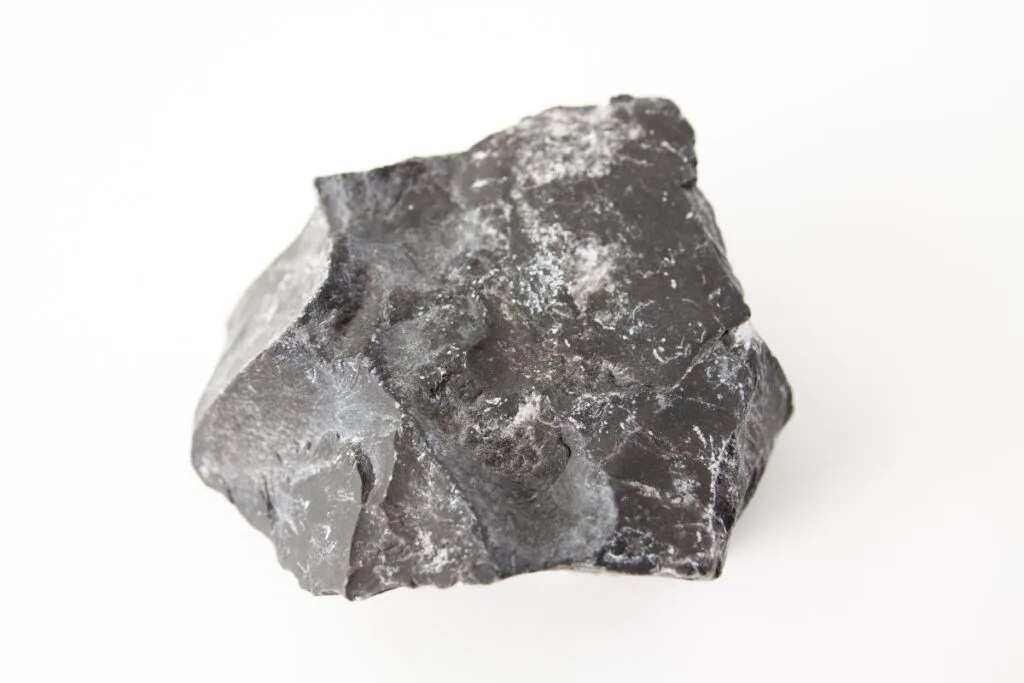
| Location | GPS Coordinates |
|---|---|
| Flagstaff | 35.176409, -111.605216 |
| Sycamore Canyon | 34.863907, -112.073610 |
| Yavapai County | 34.655366, -112.952482 |
| Oak Creek Waterfall | 34.913536, -111.718455 |
| Sentinel | 32.856336, -113.214010 |
| San Francisco Mountain | 35.342209, -111.677459 |
| House Mountain | 34.771129, -111.854753 |
Since Arizona has hundreds of extinct volcanoes and three active volcanic fields, it makes sense that this state has plenty of igneous rocks, such as basalt.
Basalt, a stone that’s easily recognized by its dark grey or black coloring and uneven texture, can be found all over Arizona, and it’s often used for decorative purposes.
Interestingly, the basalts in Arizona often contain various minerals, including feldspar, mica, quartz, and olivine, so they might reveal a slight shine when placed under light.
Any location in Arizona that’s near a volcanic field or extinct volcano is bound to have basalt. Take a trip to Flagstaff, Yavapai County, or Sycamore Canyon to find some beautiful pieces of this volcanic rock to take home.
BTW: If you are looking for the best UV light for rockhounding, find out my picks below (Amazon links):
- BEST OPTION: Convoy 8+ 365nm UV LED Flashlight with Patented Glass Filter
- BUDGET OPTION: Karrong Rechargeable 1200 Lumen 395nm UV Flashlight
- OPTION FOR INDOOR USAGE: Prime Upgraded Big Chip 396nm UV
What Minerals Are Found in Arizona
Any rockhound who’s searching for unique, colorful, or shimmering minerals will find plenty of treasures in Arizona, such as:
Turquoise
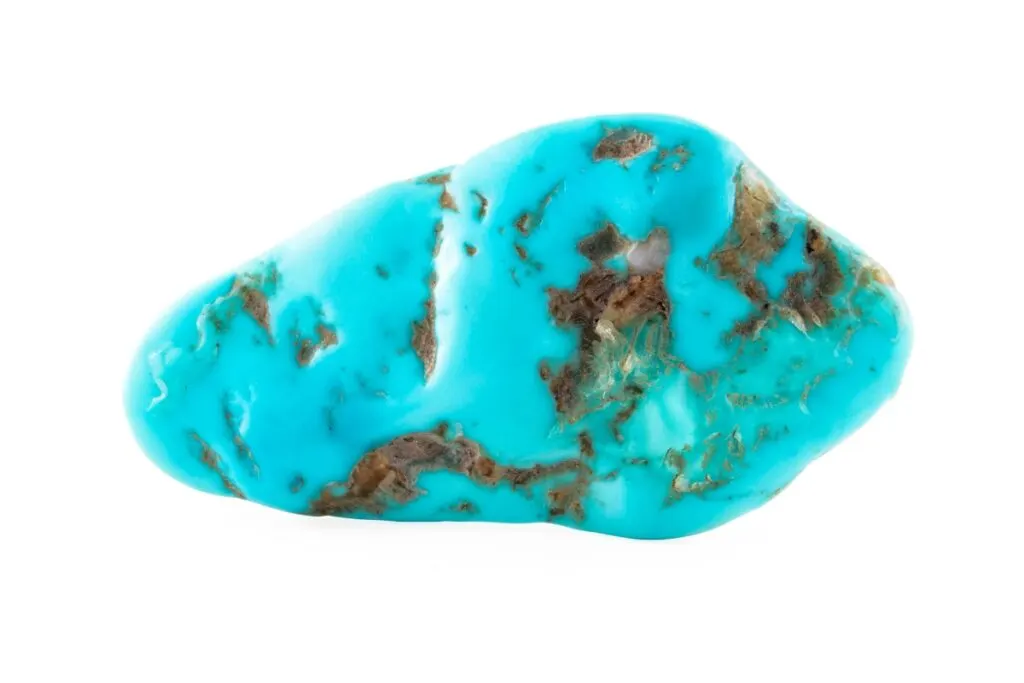
| Location | GPS Coordinates |
|---|---|
| Globe | 33.408034, -110.784477 |
| Bisbee | 31.458872, -109.935274 |
| Kingman | 35.184194, -114.027458 |
| Cave Creek | 33.859524, -111.979309 |
| Ithica Peak | 35.367283, -114.142911 |
| Morenci | 33.042961, -109.425217 |
| Castle Dome Mine | 33.399957, -110.962080 |
| Cochise County | 31.759283, -109.460748 |
Although the landscape of Arizona has many minerals, none are as popular as turquoise. As a matter of fact, turquoise was nominated as Arizona’s state gem in 1974 due to its popularity and significance to the state.
There are multiple types of turquoise that are found throughout Arizona, and each one has unique qualities and appearances.
The most common types of Arizona turquoise are Bisbee Turquoise, Sleeping Beauty Turquoise, Kingman Turquoise, and Morenci Turquoise.
Each one of these types of turquoise is named after the mine or site where they can be found, and some are more valuable than others. Each one has a unique feature that distinguishes it from the other types.
Bisbee turquoise is known for its dark blue hue and brown or red webbing while Sleeping Beauty Turquoise is favored for its Robin Egg Blue color and no webbing.
Kingman Turquoise is valued for its bright blue coloring and black or silver webbing, while Morenci Turquoise is recognized for its pyrite webbing.
Even though you might not be able to visit some of the mines where these pieces of turquoise originate, you can visit the surrounding areas.
For instance, if you want to add a piece of Sleeping Beauty Turquoise to your collection, you can explore an area that’s near the mine, such as Globe, Arizona.
TIP: Turquoise is a gemstone known for thousands of years, so a lot of fakes have appeared during that long history. Check out the differences between real and fake turquoise in the article below:
Real vs. Fake Turquoise: Check Out These 11 Key Differences
Copper
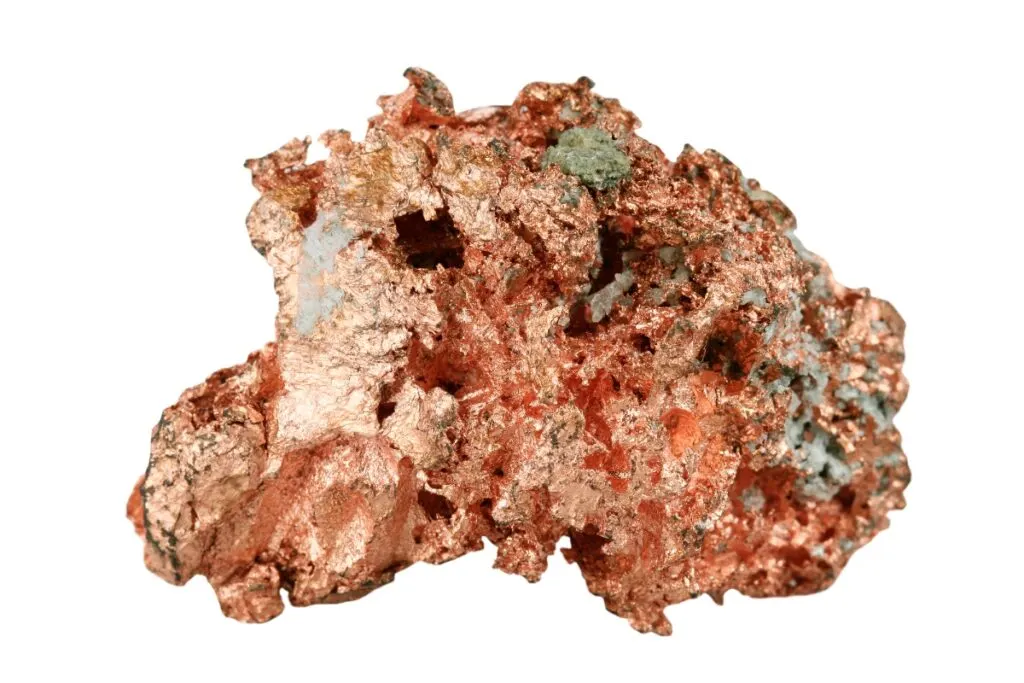
| Location | GPS Coordinates |
|---|---|
| Greenlee County | 33.091297, -109.161546 |
| Jerome | 34.744128, -112.107519 |
| Copper Creek | 32.756132, -110.467900 |
| San Tan Valley | 33.187125, -111.529602 |
| Miami | 33.394156, -110.865661 |
| Safford | 32.849648, -109.712522 |
| Pima County | 31.886056, -111.138640 |
It makes sense that “The Copper State” has more than enough copper to go around! Although copper has been mined in this state for decades, it’s still Arizona’s most abundant and valuable metallic mineral.
Arizona isn’t the largest U.S. state, but it is home to one of the largest copper mines in the world, the Morenci Mine.
All throughout Arizona, you can see statues, decorations, jewelry, and other displays that show just how significant copper is to this state and its people.
From Jerome to Greenlee, copper is abundant in many areas of Arizona, especially the southern and central regions.
Some of the best areas to visit are outside of the copper mines, as long as you do not trespass on restricted or protected lands during your trips.
Amethyst
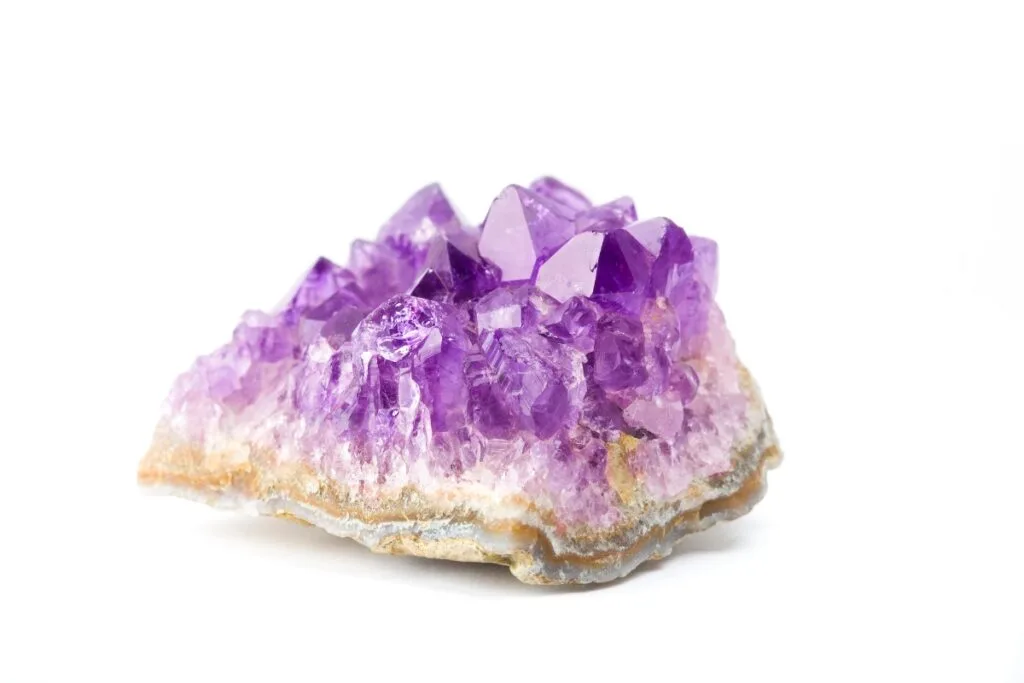
| Location | GPS Coordinates |
|---|---|
| Four Peaks Mine | 33.867874, -114.079305 |
| Peña Blanca Lake | 31.403062, -111.087210 |
| Silver Reef Mountains | 32.708630, -111.806202 |
| Cochise County | 31.469250, -109.880991 |
| Ten Strike Mine | 32.819954, -110.321479 |
| Pinal County | 33.083259, -111.340004 |
| Yavapai County | 34.404204, -112.570707 |
| Lane Mountain | 34.148994, -112.319474 |
While most people think that the best amethyst comes from Brazil, some of the highest-quality amethyst in the world actually comes from Arizona!
The most famous amethyst mine in Arizona is the Four Peaks Mine, and the stones from this mine are of exceptional color and quality.
In other U.S. states, rockhounds often find light purple amethysts, but that’s not the case with Arizona amethysts. Amethysts from Arizona are dark and rich in color, displaying magenta and red hues with royal purple.
Every rockhound who wants to add a gorgeous piece of amethyst to its collection should look near Four Peaks Mine, Pena Blanca Lake, Silver Reef Mountains, and Lane Mountain. Additionally, explore near Yavapai, Cochise, Pinal, and Graham for more of these high-quality gems.
TIP: Amethyst’s value depends on various factors like its color, the saturation of the color, or the crystal form. Find out more in the article below:
Amethyst Value: Main Factors & Prices for Different Units
Garnet
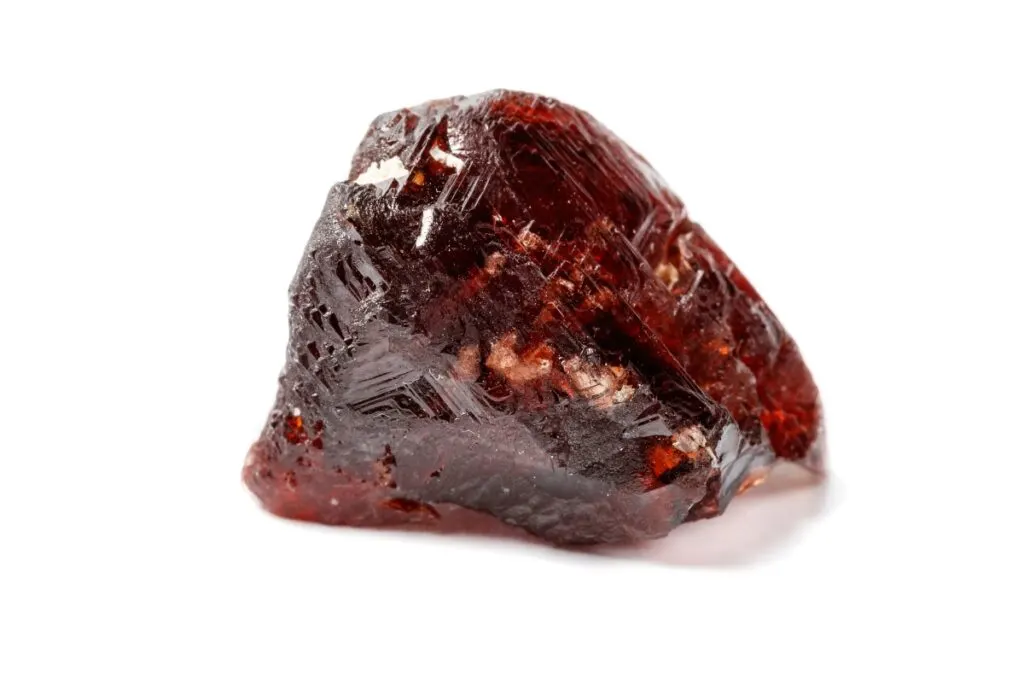
| Location | GPS Coordinates |
|---|---|
| Santa Catalina Mountains | 34.148994, -112.319474 |
| Phoenix Mountains | 33.562902, -112.031945 |
| Tucson | 32.149409, -110.825454 |
| Apache County | 36.069410, -109.562302 |
| Aquarius Mountains | 35.082708, -113.459658 |
| Graham County | 32.794924, -109.852304 |
| Santa Teresa Mountains | 32.985288, -110.303468 |
Why dig for garnets on your own when you can have hundreds of little ants gladly do the job for you? In Arizona, Southwestern Harvester Ants move garnets out of their homes and to the earth’s surface.
These garnets are called Anthill Garnets, and the Navajo Indians often pick them off the ground to sell or polish. Sadly, these types of garnets are difficult to acquire since the ants live on protected lands, and you need permission to gain entry.
However, there are many other areas where you can acquire lovely garnets in saturated green, black, and red colors.
There are many areas where you can find lovely garnets in Arizona, such as Pima County. In Pima County, you can often find garnets in lodged pegmatite rock or sitting in sandy washes.
You can also stop by Graham County, Apache County, or Phoenix to find these ruby-red stones for your collection.
TIP: There are more than twenty different species of garnets but only five species of garnets are worth cutting and polishing. Find out more in the article below:
How To Cut & Polish Garnets: Follow The 6 Simple Steps
Peridot
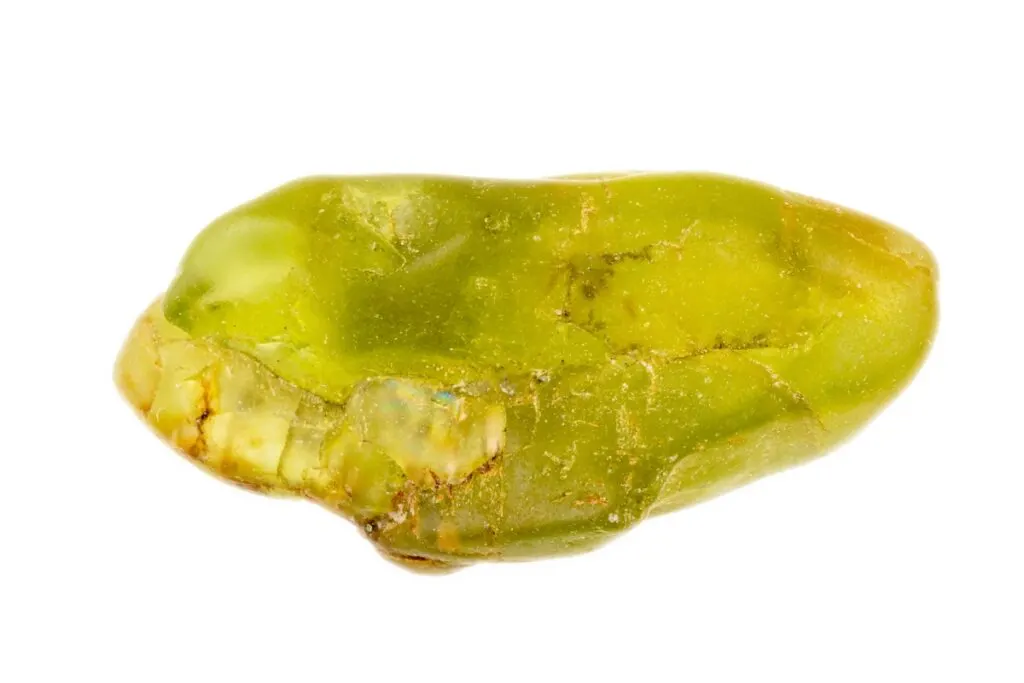
| Location | GPS Coordinates |
|---|---|
| Peridot Mesa | 33.333587, -110.483768 |
| Williams | 35.250893, -112.176534 |
| Apache County | 35.899420, -109.098176 |
| Littlefield | 36.876274, -113.934059 |
| Fountain Hills | 33.612267, -111.741462 |
| Phoenix | 33.545481, -112.028977 |
| San Carlos | 33.354304, -110.456444 |
Surprisingly, 80 to 95% of the world’s peridot supply is found in Arizona, and the majority of it comes from the San Carlos Apache Indian Reservation.
Arizona peridot is known for its beautiful coloring and exquisite quality, so it’s usually used as a decorative gemstone. Arizona locals often incorporate this lime green gem into jewelry, décor, and artwork.
When you search for peridot, the first place you should search is Peridot Mesa, a place located on the San Carlos Apache Indian Reservation.
Although the majority of peridot is found in Gila County, there are other areas you can look at, such as Apache County or Coconino County.
TIP: Arizona is the land of a miner’s dreams, a place that hums with the promise of a gold rush. Find out more about gold prospecting in Arizona in the article below:
Gold Prospecting in Arizona: 7 Best Locations & Laws
FAQ About Common Rocks & Minerals in Arizona
Before you go rockhounding in the vast deserts of Arizona, take a moment to prepare by reviewing the following FAQs:
What Rare Rocks Can You Find in Arizona
If you are searching for rare and dazzling rocks, Arizona will not disappoint. Rare rocks that are discovered in this state include fire agates, Apache tears, jaspers, and geodes.
Fire agates, which are only found in a few western U.S. states, are known for their rich, bright colors and glossy shine.
With their reddish-brown bases and flashes of red, orange, green, and gold, it’s easy to see why these agates were named after fire. If you’re on the hunt for fire agates, check out the Saddle Mountain area in Arizona.
Apache tears are small, rounded pieces of obsidian that are formed when boiling lava solidifies before it reaches the ground.
This glassy type of obsidian is only found in specific western states such as Arizona, Nevada, and New Mexico, so they are highly valued among rockhounds.
Interestingly, the name of this rock originates from a Native American legend that claims the stones are the tears of women whose husbands had fallen tragically in battle. Anyone who is searching specifically for Apache tears should look near Superior, Arizona.
Jaspers are available in large quantities all over Arizona, and the most common type of jasper is vibrant red. Rodeo Flats is well known for its beautiful pieces of jasper, so they are one of the first places rockhounds search for this stone.
Who doesn’t love to crack open a geode and discover that it’s filled with glittering crystals? Geode hunting is popular among rockhounds in Arizona since these rocks are prevalent in the state. Some of the most common types are quartz and amethyst geodes, but agate geodes have also been found in certain areas. While you can find geodes all over Arizona, some of the best areas to go include Gleeson and Flagstaff.
What Rare Minerals Can You Find in Arizona
Arizona is known for producing some of the most gorgeous and colorful minerals, including vanadinite, azurite, wulfenite, and opal.
If you are searching for azurite, wulfenite, and vanadinite, stop by the Trigo Mountains to see if you can find all three of these minerals.
Arizona azurite comes in both light and dark blue hues, so you never know which one you may find during your expeditions.
Arizona wulfenite is famous for its gorgeous sunset-orange shade and remarkable shine, and it will make a fine addition to any rockhound’s collection. Arizona vanadinite is of exceptional quality, and this state possesses the largest known deposits of it in the United States.
Opal is famous for its white coloring and rainbow shimmers, but not many people know that Arizona opal comes in other colors, such as blue and black.
One rare type of Arizona opal is called the Southern Skies Opal, which ranges from Robin’s egg blue to black in color. This particular type of opal is found in the Tubac region, which is in Santa Cruz County.
What is the Most Famous Rock or Mineral Found in Arizona
It makes sense that the most famous mineral of “The Copper State” is copper! As Arizona’s state metal, copper plays an important role not only in the rockhounding community but also in the economy.
Arizona is the largest producer of copper in the world, and this shiny reddish-gold mineral can easily be found all over the state.
While it may not be as valuable as gold, copper has all kinds of decorative or industrial uses, and it is very popular among Arizona locals. In fact, the mineral is so important to the state that copper was included on Arizona’s state flag as a single copper star.
BTW: Do you want to know more about rock and mineral identification? The books listed below are the best ones you can find on the internet (Amazon links):
- Smithsonian Handbooks: Rocks & Minerals
- Gemstone & Crystal Properties (Quick Study Home)
- Ultimate Explorer Field Guide: Rocks and Minerals (National Geographic Kids)
Conclusion
No matter where you go in Arizona, you are sure to find some unique rocks or minerals that would make any rockhound proud to own.
Whether you collect shiny minerals such as vanadinite and peridot or prefer rocks such as jasper and Apache tears, Arizona has something to offer every rockhounding enthusiast.
Regardless of where you go and what you find in the Copper State, you are sure to have a one-of-a-kind rockhounding experience that you’ll never forget!
TIP: Arizona is one of the best states in the United States for finding gemstones in the wild, and that means there are plenty of great places to rockhound there. Find out more in the article below:
Where to Rockhound in Arizona (and What You Can Find)
